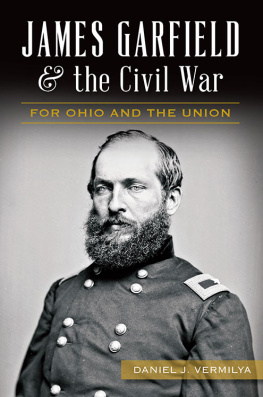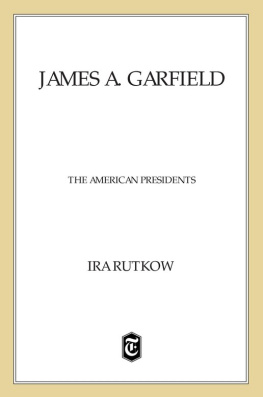The Land of Milk and Honey
T he Garfield family arrived in the New World around 1636. Edward Garfield was a Puritan who left England because of religious persecution and settled in Watertown, Massachusettsa colony that John Winthrop had founded. Edward was a simple farmer who held deep religious convictions, and his descendants lived quietly in Massachusetts for several generations.
One of Edwards descendants, Solomon Garfield, joined the army when the American Revolution began. It is not clear what the circumstances were but, during the course of the war, he lost his property and his wife. After the war, he moved in with his son, Thomas Garfield, who lived in Worcester, New York.
Thomas had several children, including a son named Abram, born in December of 1799. Two years later, Thomas died, leaving a young widow and several children in extreme poverty. As a result, Abram was sent to a farmer named Stone to work as a bound boy, doing chores around the farm to pay for his room and board. Meanwhile, Abrams mother married Caleb Boynton and began to raise a second family.
Around 1811, Abram met the Ballou family and was very attracted to their daughter, Hitty. Like Abram, Hittys father had died, and her mother, a very independent and brave woman, was raising her family by herself in the New York wilderness. Too young to openly announce their intentions, they were barely teenagers, Abram and Hitty secretly vowed to marry someday.
The Western Reserve was originally considered to be part of the colony of Connecticut, which claimed all lands west of her border. In 1800, the state of Connecticut turned over three million acres of this land along the lake to the United States government. They did so willingly because, after the American Revolution, the British government covertly encouraged the various Indian tribes in the area, that claimed the land as their hunting ground, to join forces and drive the settlers from the region therefore making the land undesirable for most settlers and developers. Most pioneers who tried to clear the land and attempted to plant fields were often forced back east or died in brutal attacks.
The huge tract has been called by various names, including New Connecticut and the Connecticut Western Reserve, before it became popularly known as the Western Reserve. The threat of an Indian attack remained real until after the War of 1812, when Great Britain finally gave up her clandestine activities and withdrew from the region. The Ballou, Garfield, and Boynton families were some of the first to settle in the area after Englands withdrawal.
In 1814, Abram and Hittys plans to marry were dashed when Hittys older brother, James Ballou, convinced the family to leave Worcester and travel to the Ohio country. The two teens promised to remain faithful to each other, and when Abram was old enough, he would travel to Ohio and claim Hitty as his wife. The opportunity to do just that presented itself two years later when Abrams mother, stepfather, and stepbrothers also decided to move to Ohio. Unfortunately, Hitty wasnt as faithful as Abram, and when the Garfield and Boynton family reached Buffalo, Abram received word that Hitty had married a man she had met in Ohio.
Devastated, Abram debated whether he should continue his journey or settle in Buffalo since his reason for going west no longer existed. After wrestling with the decision for a few days, his family convinced him to continue the journey with them and to at least see what the Ohio country could offer. Ironically, the clan settled in Muskingum County, not too far from where Hittys family had settled. One day, Abram went by to pay his respects to one of Hittys uncles and was reintroduced to one of Hittys younger sisters, Eliza. She was two years younger than Abram and when they had lived in New York, he had not paid much attention to her, but at that moment, he noticed that she had grown into a lovely woman.
Eliza had not paid much attention to Abram back in New York either, considering him to be just a boy. However, after seeing what a strong and handsome man he had become, she quickly changed her mind. After a proper courtship, they married and moved north to the Western Reserve.
For the first eight years of their marriage, Abram and Eliza Garfield did not have a house or even a permanent residence. They stayed with various relatives around Newburgh, including Abrams younger brother, Thomas, and half-brother, Amos Boynton. Abram farmed for a while in Cuyahoga County and eventually was hired to build part of the Ohio and Erie Canal.
After Amos Boynton married another one of the Ballou girls, Alpha, in 1826, the two half-brothers bought adjoining parcels of land in Orange Township. Amos quickly cleared his land and built a log house, but Abram was hesitant to follow suit. He had made pretty good money on the canal, and he had dreams of becoming rich enough to buy a big house in Cleveland. With the success of the Ohio and Erie Canal, Abram invested in and began working with another canal project in Tuscarawas County that planned to link Cleveland with the Ohio River. This ambitious project was doomed from the beginning, however, and was soon abandoned. Abram lost almost everything he had in the venture, so he left canal work forever and finally took up farming with Amos.
Abram did not have much in the way of a formal education, nor did he possess much natural business sense, which was apparent with his investment in the canal project, but he was a strong man with great physical power, large bones, (and) big muscles.
By the time Abram and Eliza Garfield settled on the Western Reserve in 1829, there were a number of small towns and family farms springing up in the area. However, it was still a very rural setting. Cleveland, the largest community, only had 1,076 residents but no railroad. And although the threat of Indian attacks had vanished and it was considered safe to immigrate to this land, it was still very much a backwoods wilderness.
Many of the new settlers on the Western Reserve wanted nothing to do with the established church. In fact, one reason many had traveled to the frontier was to avoid organized religion. One author wrote that the clergy magnified their office, and were careful to impress the masses that they alone could understand the Bible even though many of them considered it a dead letter. Church membership was at an all-time low.
In spite of that, there still were churches on the reserve, and there was much interest in spiritual matters. Congregational and Presbyterian churches were the strongest and oldest Christian communities in the area because most of the settlers had grown up in those congregations back east, but a Baptist church had also been established on the reserve in 1790. In addition, Methodist circuit riders covered the area around present-day Youngstown, Ohio, as early as 1803. However, even if the residents in the Western Reserve wanted to go to church, churches were not always within easy riding or walking distance. Families would often worship at home resulting in an independent spirit that no longer needed or wanted established denominations.










